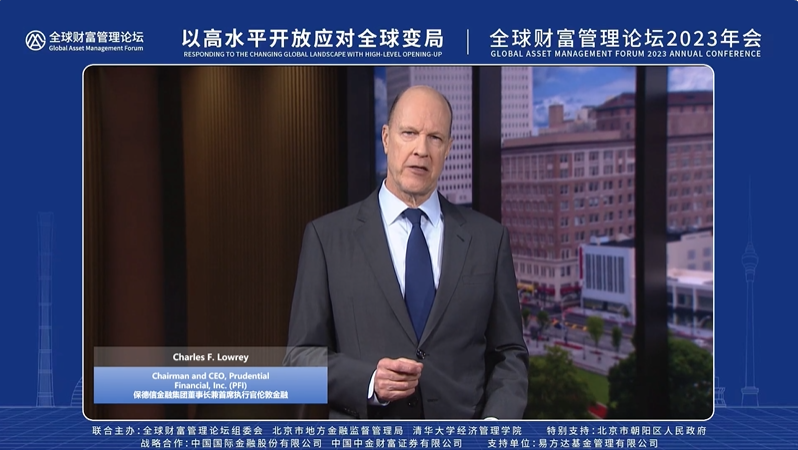保德信金融集团Charles F. Lowrey:支持养老保障的实践经验与启示
Charles F. Lowrey分享了保德信在养老保障业务的三个重要实践经验。第一,强有力的养老金体系需要三个支柱,包括国家体系、雇主体系和个人储蓄体系。但三个支柱的增幅往往不同,相应的监管监督机制也差别很大,需要出台配套政策促进三大支柱的协调配合。第二,简单、低成本、带有自动选择特征的产品更有可能提高人们的参与度。第三,充分应对人们想要通过投资为以后的生活提供可靠收入的需求。关注开发创新的解决方案,提供合适的支取型产品和服务,确保人们退休后可以想要的财务结果。

大家好。非常感谢能有这次机会,与各位尊敬的、有影响力的嘉宾交流。
我想先介绍一下保德信金融集团的情况。各位可能知道我们在中国叫“保德信”。大家会发现,保德信(Prudential)与英国保诚集团(Prudential Plc)的英文名相同。很多年前,两家公司选择了同样的名字,只是当时没人想到,保德信和保诚后来都成长为全球性公司。
美国的保德信,常用的简称是 PFI,创始于1875年,当时的使命是为工薪家庭提供财务保障,主要是通过丧葬保险的方式。现在,我们已经发展成一家全球性的保险和资产管理公司。但我们始终坚守初心,那就是,通过解决千变万化世界中的财务挑战,让生活变得更加美好。
今天,保德信在40 多个国家拥有4万多名员工,每天都在帮助我们的客户加强财务韧性。我们有一个共同愿景,那就是:在增强投资、保险和退休保障方面成为全球领导者。
各位会看到保德信的宗旨和愿景时时刻刻贯穿着公司的方方面面。我们的优势之一是各业务组合相关、互补。PGIM是保德信的全球资产管理业务,是全球最大的资产管理公司之一,资产管理规模超过 1.2 万亿美元。PGIM在20个国家设有经营机构,为零售和机构投资者提供解决方案,涵盖公私募固收、基本面权益投资、量化权益投资、房地产和另类投资等广泛资产类别。PGIM 通过统筹上述能力,向主权财富基金、养老基金和中央银行等世界各地的专业投资主体提供定制的解决方案。
保德信的保险业务在美国和世界多个国家拥有市场领先地位。保德信国际保险业务承保了来自13个国家近1200万份有效保单。为满足当地需求,保德信提供了一系列定制化解决方案,包括寿险、养老险、意外险、健康险产品以及其它金融服务。
在美国,保德信的团险和个险业务为超过2800万名客户提供保障。实际上,保德信是美国最大的人寿保险公司,全球有效寿险保单保额达4万亿美元。保德信美国的退休业务为200多万人提供退休财务保障,并为超过7500家企业和协会的退休人员提供养老金计划保障。
保德信进入了亚洲市场已逾三十载,目前在亚洲的业务体量庞大,保持增长态势。在过去的五年中,亚太一直是PGIM业务增长最快的地区。截至2022年底,PGIM在亚洲的资产管理规模超过2300亿美元。在中国,自2004年以来,PGIM一直通过与光大证券的合资公司——光大保德信基金管理有限公司来积极参与在岸市场。1998年,保德信国际保险设立北京代表处,开始涉足中国的保险业务。之后在2012年与复星国际成立了合资寿险公司,也就是总部位于上海的复星保德信人寿保险有限公司。基于我们的经营宗旨、业务范围和以客为尊的理念,全球老龄化,以及金融服务企业要发挥何种作用,来解决老龄化产生的广泛影响这些问题,对于保德信而言极其重要,相信对在场的各位和各位所在的机构也一样。
好消息是,人口老龄化的趋势可以预测,数据也很清楚。我们一起来看一看下列数据:过去十年中,全球70岁及以上人口增加了6.27亿,占总人口比例从5%上升到12% [1 ]。 十年后,全球总人口达到80亿,其中的 16%将超过70 岁 [2]。 到2050年,80 岁及以上的人口数量预计将增长三倍,从2019年的1.43亿增至4.26亿 [3]。
中国已经采取措施来应对人口变化带来的影响。随着面临类似问题的国家越来越多,他们可能会向中国寻求政策和实践层面的参考,以应对这些巨大的转变。虽然各个国家和地区的老龄化程度不同,但全球人口老龄化将对劳动力供给、市场和经济产生重大影响。
对于政企领导人,我们发现几点重要启示:最紧迫的问题之一,是现实中大多数人还没有为养老做好充分准备。仅靠政府无法解决养老储蓄和养老需求之间的差距。全球范围内,私营部门必须帮助改善人们的财务情况。这为金融服务公司提供了一个巨大的机会,要要勇于承担提供其他行业无法提供的服务和解决方案。
其次,作为一个行业,我们要加倍努力开发产品、服务和系统,使更多的人能够享受财务安全,安度晚年。努力的方向必须包括提供创新产品,使雇主能够为雇员提供有效的养老计划和养老工具。
在保德信,我们有机会与世界很多国家共同探讨应对挑战的想法和方案。例如:PGIM与许多国家的养老体系合作过,包括一些世界上最大的养老体系,也有规模适中的养老体系。在保德信的国际保险业务方面,我们通过制定战略、打造能力来解决对养老产品日益增长的需求,提供寿险保障和各类解决方案,确保安稳的退休生活。在美国,保德信一直站在最前沿,与10万余名金融专业人士和顾问一道,推陈出新,提供金融解决方案,加强数百万人的退休保障。同时,我们也在通过创新,帮助雇主兑现数十亿美元养老计划的承诺,提供福利项目,满足雇员的个人需求和企业的业务要求。
根据保德信的经验,我们认识到永远不存在能满足每个国家每种需求的通用解决方案。我能够分享的是保德信在构建扎实体系、支持养老保障方面所汲取的一些重要经验教训。
首先,特别是对比较大的国家来说,重要的是三支柱协同支持养老保障:国家体系、雇主体系和个人储蓄体系。显然,随着近期中国首次推出个人养老金制度,中国已经认识到亟需鼓励个人为养老进行储蓄。根据保德信在美国以及其他地区的经验,我们知道三支柱的增速不同,相应的监管监督机制差别也很大。遗憾的是,这往往意味着三者不能很好地协同,导致政策和方案不清晰。美国已经建立起了三大支柱,但安稳退休对相当一部分美国人来说仍然遥不可及。美国最近通过《安全退休储蓄法案》和《安全退休储蓄法案 2.0》立法,这是政府在保德信等公司的大力鼓励和大量投入下,为改善养老储蓄制度所采取的诸多举措之一。
我们汲取的第二个教训是提供简单的产品很重要。我们太多次看到一些国家试图通过推出复杂的解决方案和产品来解决多种需求,却没有成功。相反,我们看到提供基础产品,配以较低的费用,就有可能提高参与度。例如,经验告诉我们,一个设计良好的养老计划应该随着人们需求的变化,提供自动注册、缴费金额自动增加、自动匹配合适的投资产品等特性。简单来说,如果我们让养老储蓄变得更容易,人们就会去做。
我想分享的第三个教训是,要充分应对人们想要通过投资为日后的生活提供可靠收入的需求。作为一个行业,我们一直专注于帮助人们通过积累储蓄给未来的财务安全打基础。我们需要更加注重开发创新的解决方案,帮助人们在退休后确保和保护他们所期望的财务结果。这意味着要提供合适的支取型产品,确保他们退休后有现成可用的资金。我们发现,这需要结合保险产品和投资产品,首先使储蓄增值,然后提供可预测的稳定的终身收入。在中国这样的国家尤其如此,随着父母和亲人年龄的增长,能够帮助他们的孩子越来越少。随着人均寿命的延长,我们比以往任何时候都更需要帮助人们为此做好准备,也更需要建立能够解决长寿风险的养老制度。
总结而言,通过养老保障业务,保德信学到了三个重要教训:第一,强有力的养老金体系需要三个支柱,也就是国家、雇主和个人的良好配合以支持足够的积蓄。第二,简单、低成本、带有自动选择特征的产品更有可能提高参与度。第三,我们必须把重点放在可以积累储蓄和提取储蓄的产品和服务上,以确保退休人员能够获得足额和定期的收入来源。
建立一套健全的养老保障体系的好处是深刻和长远的。金融服务行业有专业知识,我认为也有责任发挥更大的作用,帮助世界各地更多的人获得退休保障。我相信我们有能力应对挑战。我期待不断与世界各地的商界政界领导人沟通,提供我们需要的创新解决方案。保德信非常重视我们在中国建立的合作伙伴和业务关系。我们希望扩大公司在华业务范围,把保德信的专业知识和解决方案带给全国各地更多的人。
感谢各位聆听,感谢今天有这样的机会和各位交谈,也感谢各位为持续推动对话与合作做出的努力。
数据来源:
[1]《世界人口展望》,2019 年
[2]《哈佛商业评论》,11/18/22
[3] 《世界人口展望》,2019 年
![]()
Hello. Thank you for the opportunity to address this esteemed and influential group.
I’d like to begin by sharing information about Prudential Financial. In China, you may know us as “Bao De Xin.” You’ll note that in English, we share a name with Prudential plc of the UK. That reflects an agreement between the two firms many years ago, when no one anticipated we would both evolve into global companies.
Prudential of the United States – or PFI, as we often go by– was established in 1875 with a mission of providing financial security to working families, primarily through burial assurance. We have grown to become a global insurance and asset management firm. But we have stayed true to our purpose – to make lives better by solving the financial challenges of our changing world.
Today, we have over 40,000 employees in more than 40 countries, who help our customers and clients strengthen their financial resiliency every day. We are guided by a shared vision – to be a global leader in expanding access to investing, insurance, and retirement security.
You’ll see our purpose and vision reflected in every aspect of our company, every day. One of our strengths is our mix of interrelated and complementary businesses. PGIM, our global asset management business, ranks among the largest asset managers in the world, with over $1.2 trillion in assets under management. With offices in 20 countries, PGIM’s businesses offer solutions for retail and institutional investors across a broad range of asset classes, including public and private fixed income, fundamental equity, quantitative equity, real estate and alternatives.By combining these capabilities, PGIM delivers tailored solutions to sophisticated investors around the world, including sovereign wealth funds, pension funds and central banks.
We also have market-leading insurance operations in the U.S. and around the world. Through our International Insurance operations, we have nearly 12 million policies in force in 13 countries.These businesses provide a range of solutions tailored to meet local needs, including life insurance, retirement, accident, and health products, as well as other financial services.
In the U.S., we protect more than 28 million lives through our group and individual life insurance operations. In fact, we are the largest U.S. life insurer with $4 trillion of gross life insurance in force worldwide.We also protect financial outcomes in retirement for more than 2 million people, through our U.S. retirement operations. And we safeguard retiree pension plans for over 7,500 businesses and associations.
As a firm, we have a large and growing presence across Asia, a region we entered more than 30 years ago. Asia-Pacific has been the fastest-growing region for PGIM over the past five years. At the end of 2022, PGIM had more than $230 billion assets under management in Asia. In China, PGIM has been actively involved in the onshore market since 2004 through a joint venture with Everbright Securities, called Everbright PGIM Fund Management. Our International Insurance operation established its footprint in China in 1998 with a representative office in Beijing. Then, in 2012, through a joint venture with Fosun International, we founded the Pramerica Fosun Life Insurance Company, which is headquartered in Shanghai.
Based our purpose, business lines and care for our customers, the issue of global aging – and the role financial services firms can play in addressing its wide-ranging impact – is of critical importance to us, just as it is to all of you and your organizations.
The good news is that demographic trends on aging are predictable, and the data is clear. Consider these statistics: Over the last decade, the global population of age 70 and above grew by 627 million, from 5 percent to 12 percent of the total population.[1] 10 years from now, 16% of the 8 billion people on earth will be over 70.[2] And by 2050, the number of people aged 80 years and older is projected to triple, from 143 million in 2019 to 426 million.[3]
In China, you’ve already taken steps to address the impact of these demographic trends. As more nations face similar issues, they’ll likely look to China for guidance on policies and practices to address these dramatic shifts. While specific rates vary across regions and countries, the aging of the global population will have substantial impact on labor pools, markets and economies.
For government and business leaders, we see several important implications: One of the most pressing issues is the reality that most people aren’t sufficiently prepared for retirement. Governments alone cannot close the gap between retirement savings and retirement needs. The private sector has to help improve financial outcomes for people around the globe.This presents a tremendous opportunity for financial services firms to step up and deliver services and solutions that no other industry can.
Second, as an industry, we need to redouble our efforts to develop products, services and systems that enable more people to benefit from financial security through old age. These efforts must include delivering innovative offerings that enable employers to provide workers with effective retirement plans and tools.
At PFI, we’ve had the opportunity to explore ideas and options for addressing these challenges with countries around the globe. For example,PGIM has worked with pension systems in many countries, including some of the world’s largest systems, as well as others of more moderate size. In our International Insurance operations, we’re addressing the increasing demand for retirement products by building strategies and capabilities to provide both life insurance protection and solutions to ensure a secure retirement. In the U.S., we’ve been at the forefront of identifying and advocating for ways to improve retirement security for millions of individuals, in partnership with more than 100,000 financial professionals and advisors. At the same time, we’re innovating to help employers keep billions of dollars of retirement plan promises and deliver benefit programs that meet workers’ individual needs, and their business requirements.
From our experience, we recognize there will never be a universal solution that meets every need in every country. What I can share are some of the key lessons we’ve learned about constructing a solid structure to support retirement security.
First, especially for larger countries, it’s important to have three pillars that work together to support retirement security -- a state system, an employer-sponsored system, and a system for individual savings. It’s clear with the recent launch of China’s first private pension scheme, the country recognizes the urgent need to encourage individuals to save for retirement. From our experience in the U.S. and elsewhere, we know these pillars grow at different rates and are managed according to very different regulatory and oversight regimes. Unfortunately, that often means they don’t work well together, resulting in confusing policies and programs. In the U.S. we have all three pillars in place, but there is still a significant portion of the population for whom a secure retirement remains out of reach.The recent passage of legislation, called the SECURE Act and SECURE Act 2.0, is one example of steps our government is taking, with strong encouragement and significant input from companies like PFI, to improve the retirement savings system.
A second lesson we’ve learned is the importance of offering simple products. Too often, we see countries attempt to address multiple needs by rolling out complicated solutions and products that don’t succeed.Instead, we’ve seen that by offering basic products, at lower fees, it is possible to increase participation. For example, experience has taught us that a well-designed retirement plan should offer automatic enrollment, escalation of savings, and enrollment in suitable investments, as people’s needs change. Simply put – if we make it easier for people to save for retirement, they will.
The third lesson I’d like to share is the importance of accounting for people’s need to receive dependable income from their investments later in life. As an industry, we’ve been keenly focused on helping people lay the groundwork for a secure financial future by accumulating savings.We need to focus more on developing innovative solutions that help people secure and protect their desired financial outcomes in retirement. That means delivering the right kinds of decumulation products, to ensure they have readily available funds during retirement. We’ve found that requires combining insurance and investment products to allow first for growth, and then delivery of predictable, protected income for life.That’s particularly true in places like China, where fewer children are available to help their parents and other loved ones as they age. As people live longer, it’s more important than ever that we help them prepare for, and have retirement systems that address, the risks that come with increased longevity.
To summarize, the three key lessons we’ve learned through our work on retirement security are: First, strong pension systems need three pillars – state, employer and private – that work well together to support adequate savings. Second, simple, low-cost products, with automated features are more likely to increase participation. And third, we must focus on products and services that allow for both accumulation and decumulation of savings, to ensure retirees have access to a sufficient and regular stream of income.
The benefits of establishing a sound system of retirement security are profound and far-reaching. The financial services industry has the expertise – and I believe the responsibility –to play an even greater role in helping ensure retirement security for more people around the world. I am confident we are up to the challenge. And I look forward to continuing to engage with business and government leaders around the world to deliver the innovative solutions we need. We greatly value the partnerships and relationships we have established in China.And we look forward to expanding our presence and bringing our expertise and solutions to more people across the country.
Thank you for your time and the opportunity to speak to you today. And thank you for your ongoing commitment to dialogue and collaboration.
(Sources of data:
[1] World Population Prospects, 2019
[2] Harvard Business Review, 11/18/22
[3] World Population Prospects, 2019)

